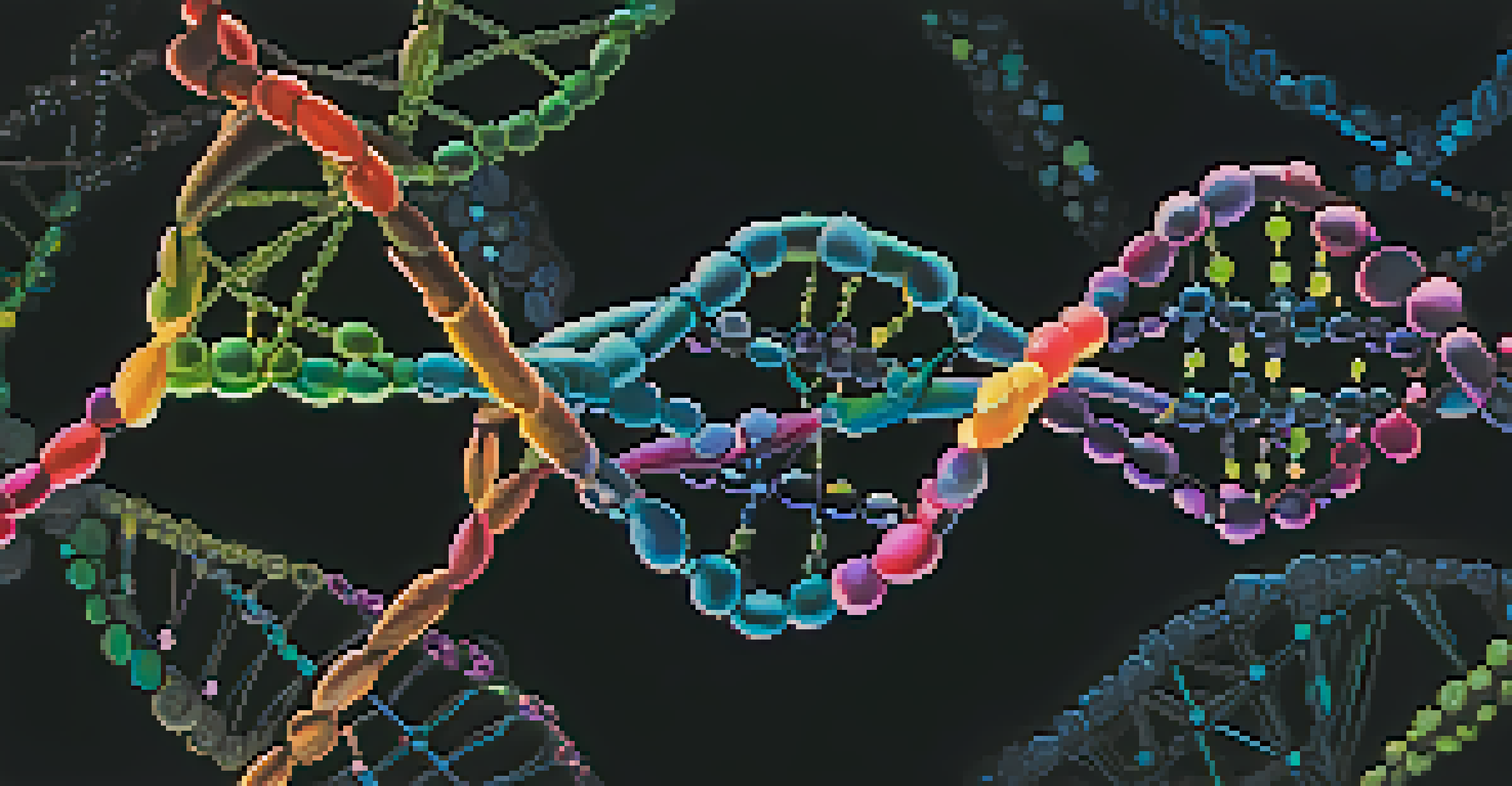How Molecular Techniques Transform Plant Taxonomy Research

Understanding Molecular Techniques in Plant Taxonomy
Molecular techniques refer to methods that analyze biological molecules, such as DNA or RNA. These approaches have become crucial in plant taxonomy, as they provide a deeper understanding of genetic relationships among species. Rather than relying solely on physical characteristics, researchers can now uncover the genetic makeup of plants to classify them more accurately.
The study of plant taxonomy is about understanding the relationships among living organisms, and molecular techniques allow us to delve deeper into these connections than ever before.
For instance, DNA sequencing allows scientists to identify specific genes that are unique to certain plant species. This molecular data often reveals surprising connections that can change our understanding of plant evolution. By integrating these techniques, taxonomy is evolving from a purely observational science into a more precise and data-driven field.
Ultimately, these molecular techniques empower researchers to create more reliable classifications and understand biodiversity at a genetic level. This shift not only enhances our knowledge of plant relationships but also informs conservation efforts, ensuring that endangered species are correctly identified and protected.
The Role of Phylogenetics in Plant Classification
Phylogenetics is a branch of biology that studies the evolutionary relationships among species. By comparing genetic material from different plants, phylogenetics allows researchers to construct family trees that illustrate how various species are related. This method has significantly impacted plant taxonomy by providing a clearer picture of plant lineages and their evolutionary history.

For example, molecular phylogenetics has helped clarify the relationships between previously misunderstood plant families. As researchers analyze genetic data, they can identify common ancestors and track how species diverged over time. This clarity fosters a better understanding of plant diversity and aids in the discovery of new species.
Molecular Techniques Enhance Taxonomy
Molecular techniques, like DNA sequencing, provide deeper insights into plant relationships, transforming taxonomy from observational to data-driven.
In essence, phylogenetics transforms our approach to plant classification, making it more dynamic and evidence-based. With a solid phylogenetic framework, taxonomists can better understand the complex web of life, paving the way for new discoveries and insights in botany.
DNA Barcoding: A Game Changer for Plant Identification
DNA barcoding is a molecular technique that uses short genetic sequences to identify species. This method has become a game changer in plant taxonomy, allowing for rapid and accurate identification of plants. By focusing on specific regions of DNA that vary between species, researchers can differentiate even closely related plants that might look similar.
Genetic sequencing is not just a tool; it's a lens through which we can view the intricate tapestry of life on Earth.
For instance, a field botanist might struggle to tell apart two species of flowering plants just by their appearance. However, with DNA barcoding, a simple leaf sample can provide conclusive results in a matter of hours. This efficiency is especially valuable for biodiversity studies and ecological monitoring.
Furthermore, DNA barcoding has implications for conservation efforts, as it helps identify rare or endangered plant species that might otherwise go unnoticed. By ensuring accurate identification, conservationists can prioritize efforts to save species that are most at risk, contributing to biodiversity preservation.
Molecular Markers: Unraveling Genetic Diversity
Molecular markers are specific sequences in the DNA that can be used to identify genetic variation within and between species. These markers are crucial in plant taxonomy as they help researchers assess the genetic diversity of plant populations. By examining these markers, taxonomists can understand how plants adapt to different environments and identify potential new species.
For example, researchers may discover that two populations of a plant species show significant genetic differences, indicating that they may be evolving separately. This kind of insight is invaluable for conservation strategies, as it highlights the importance of preserving genetic diversity within species.
Phylogenetics Clarifies Plant Lineages
Phylogenetics uses genetic comparisons to construct evolutionary family trees, offering clarity on plant diversity and relationships.
In summary, molecular markers provide a window into the genetic complexities of plant life. They enable taxonomists to make informed decisions about conservation and help identify evolutionary patterns that might not be visible through traditional classification methods.
Integrating Molecular Techniques with Traditional Methods
While molecular techniques are transforming plant taxonomy, integrating them with traditional methods remains essential. Field observations, morphological studies, and ecological data still play a vital role in understanding plants in their natural habitats. By combining these approaches, researchers can create a more holistic view of plant diversity.
For instance, a taxonomist might use molecular data to support findings from field studies, such as the distribution of a particular plant species. This combination strengthens the overall classification and provides a more comprehensive understanding of plant relationships. It also ensures that the rich history of botanical knowledge is not lost in the face of new technologies.
This synergy between molecular and traditional methods enhances the rigor of taxonomic research. By leveraging the strengths of both approaches, researchers can tackle complex questions about biodiversity and evolution more effectively.
Challenges in Implementing Molecular Techniques
Despite the advantages of molecular techniques, there are challenges that researchers face in implementing them. One major hurdle is the cost associated with molecular analyses, which can be prohibitive for some research projects. Additionally, access to advanced technology and training in molecular methods can be limited in certain regions.
Moreover, the interpretation of molecular data can be complex and requires a solid understanding of both genetics and bioinformatics. Researchers must be equipped to analyze and interpret vast amounts of genetic information accurately. This complexity can deter some botanists from fully embracing molecular techniques.
Future of Taxonomy: AI and CRISPR
Emerging technologies such as AI and CRISPR promise to advance plant taxonomy research, unlocking new discoveries in plant classification and biodiversity.
Nevertheless, overcoming these challenges is crucial for the future of plant taxonomy. As technology continues to advance and become more accessible, the integration of molecular techniques into taxonomic studies will likely become the standard, propelling the field forward.
Future Directions in Plant Taxonomy Research
The future of plant taxonomy is exciting, especially as molecular techniques continue to evolve. Advances in technologies like CRISPR and high-throughput sequencing promise to deepen our understanding of plant genetics. As these tools become more accessible, we can expect to see groundbreaking discoveries in plant classification and biodiversity.
Additionally, the integration of artificial intelligence (AI) into molecular taxonomy could revolutionize how researchers analyze genetic data. AI can assist in recognizing patterns and making predictions about plant relationships, streamlining the research process. This potential for innovation highlights the need for ongoing collaboration between molecular biologists and taxonomists.

In conclusion, as we stand on the brink of a new era in plant taxonomy, embracing molecular techniques will be key to unlocking the mysteries of plant diversity. With continued investment in research and technology, the future holds great promise for understanding and conserving our planet's flora.